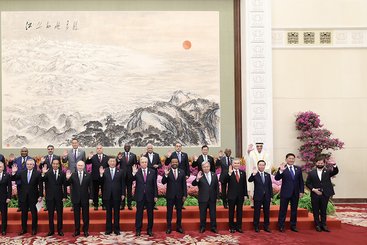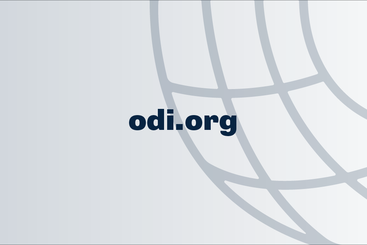This note is based on a recent visit to China to speak at the Tongzhou Forum, Renmin University, on China’s Global Development Initiative. There was little controversy aired at the Conference, rather a series of eulogies about Chinese development, the success of the Belt and Road Initiative and President Xi’s new, positive thinking about China’s engagement in the world. The last is based on the support for the UN’s Development Goals within the Global Development Initiative and parallel Initiatives through the Global Security Initiative and Global Civilisation Initiative. Chinese aid, through its China International Development Cooperation Agency, contributes positively but, it was argued that, as a middle-income country, China, unlike the West, does not have a major responsibility for the large amounts of money required for development and climate finance.
That view of the world is however coming under attack from several sources. One, which was reflected in the 2023 UK government White Paper on development, challenges the view that China is a role model for development and regards its activities in the Global South as in many respects malign and a threat. Part of the Western scepticism about the Chinese growth model is the criticism that it worked at a low level of development in forcing high levels of capital accumulation, but is unsuited to the next step of advancing from middle to high income status. Another view is that China’s experience of development may, indeed, be a big success and its wider influence benign. But China can no longer pretend to be a poor country and needs to pull its weight in providing concessional aid flows, preferably through multilateral channels. This blog unpicks the major criticisms aimed at China
China as a Growth Model
There is a broad consensus that, at least since 1980, China has provided a major success story in development defined by poverty reduction. In the 40 years since 1980, China saw 800 million people lifted out of extreme poverty (measured by the current World Bank metric of $2.15 a day). China accounted for two thirds of the global total of absolute poverty reduction. Extreme poverty, at this level, has largely disappeared in China. Although there were earlier successes in the Asian NICs, such as Korea and Singapore, and there continue to be important successes, as in Bangladesh and the southern states of India, China is arguably THE success story for economic development: certainly, at scale.
There is, however, much debate as to what weight should be attached to different factors. A major influence on China’s poverty reduction was the role of ‘reform and opening up’ under Deng and his successors. There is more disagreement over the importance of the legacy of the previous Mao era: equality of land ownership; high savings rates; a relatively healthy population with a generally high level of education. There is also some disagreement over how crucial the ‘opening up’ – globalisation – was relative to internal factors. Some of the hostility to China in the USA is fed by the belief that China’s success in development was largely created by China joining the WTO and exploiting open markets overseas, seen as a zero-sum game which China won and the USA lost.
There is also debate as to how much of China’s success is due to what the World Bank calls ‘effective governance’ and the Chinese call the ‘leadership of the Communist Party’. It is obviously uncomfortable in the West to have to concede that after the supposed discrediting of the Communist system with the collapse of the Soviet Union, a Communist Party could have delivered a remarkable development success (also in Vietnam). It may be that the name is misleading since Communism in China is state capitalism in practice. But, whatever the label, China had the benefit of clear, long-sighted, consistent, leadership with the capacity to deliver massive improvements in infrastructure and sustained high levels of investment: none of which would be easy, and probably impossible, in a Western-style democracy.
The current criticism of the Chinese growth model is, however, largely based on two further points. The first is that poverty reduction, however important, is a rather narrow definition of development. It fails to capture some of the elements of development beyond basic survival represented by a wider definition of ‘human rights’: freedom of individual expression and choice; freedom to pursue a religion or cultural identity, or sexual and reproductive preference outside the approval of the state. Nor does the Chinese conception of development attach importance to institutions (like an independent judiciary) or institutional transparency. The second is that the Chinese model does not work so well in addressing the challenges of high-income countries, which centre on sustaining productivity growth through innovation or addressing ‘quality of life’ issues. China is said to be at danger of being stuck in a ‘middle income trap’.
For these reasons, the idea that the Global Development Initiative (GDI) can be a copy of Chinese development experience is being strongly contested in the West. However, in the Global South the sceptical response is likely to be that they like the vison of free and open democratic societies and Western lifestyles, but the basic task of development through poverty reduction isn’t easy and the Chinese offer the best example of how it can be done quickly and at scale.
A Benign or Malign Influence?
Before the ‘reform and opening up’ period began in the 1980’s, China’s interest in the Global South was largely concerned with promoting Maoist revolution or cultivating a few countries which supported China’s development model. I worked in East Africa in the 1960’s and saw the cultivation of Tanzania, leading to the TanZam railway (which is now largely unused).
In recent years, difficulties in accessing long term development finance from OECD countries has led many developing countries to turn to new sources: bond markets and loans from banks and export credit agencies of emerging market economies including China. It is estimated that in the period 2008-21 China made around $500bn in loan commitments to middle and low-income economies, which is over 80% of the amount advanced by the World Bank. Chinese sources talk about funding of twice that amount for infrastructure lending and ‘bail-out’ funding but, in truth, the numbers are difficult to verify.
Much of the infrastructure was financed as part of the Belt and Road Initiative (BRI). There is an extensive literature on the BRI. This literature explores the motives behind the BRI, which include a self-interested wish to secure raw materials for China, offload surplus capacity in industries like steel and promote the commercial interests of Chinese banks as well as to engender goodwill in recipient countries and to advance global connectivity. It also evaluates the impacts in developmental terms. In summary, the large infrastructure projects range from the good and bad to the ugly, though this could also be said of much Western development finance, especially from bilateral sources. Western official agencies do however subscribe to standards set by the OECD
One undoubted consequence of China’s BRI lending has been an accumulation of debt to Chinese banks. And this is a significant factor for the 10 to 12 countries in extreme distress (defined by the World Bank) and the 50 to 55 countries estimated by the United Nations to require assistance in managing debt. There has long been criticism from some Western sources that the Chinese were trying to engineer a ‘debt trap’ in order to gain control over assets pledged as collateral or to advance geo-political interests. Serious academic analysis by Brookings and Chatham House dismisses the ‘debt trap’ accusations. But there is, undeniably, a legacy of debt often without the additional revenue to service it. Between 2000-2021, it is estimated that the share of public debt of low and lower-middle income countries owed to private bond holders rose from 10 to 50% and to Chinese entities from 1 to 15%; the share of Paris Club debt - OECD official lenders- fell from 55 to 18%. Chinese entities have not coordinated debt relief directly with OECD creditors but offered debt relief in parallel during the pandemic and are negotiating debt relief bilaterally.
The British government offers a scathing criticism of the Chinese performance: ‘operating at lower social and environmental standards; limited transparency; allegations of corruption and capture of local elites; and limited coordination through the multilateral system, especially of bilateral initiatives like the BR’. To this China could offer two defences. One is that the counterfactual alternative to Chinese financing of infrastructure is not ‘better’ long term financing from developed countries, but nothing at all (or, for some commercially marginal projects, extremely expensive commercial funding). The British government is not offering to replace Chinese funding with, better, British project finance; indeed, the concessional aid, element in financial flows is being cut.
The other defence is that China would be more committed to working with multilateral institutions, such as the IMF, World Bank and regional banks, if its voting share – and, thence, its share in decision making – more accurately represented its economic size. Along with other countries in the Global South, China has long, unsuccessfully, demanded a reform in voting shares which were agreed long ago when the centre of gravity of the world economy was elsewhere. China sought to counter this imbalance by prompting the establishment of the Asian Infrastructure Bank (AIIB) in which it has the largest shareholding. The AIIB has, so far, won a reputation for professionalism and works closely with the World Bank.
Why Isn’t There More Chinese Aid?
Another line of criticism of Chinese performance in overseas development is that the supportive rhetoric around GDI and the criticism of high-income countries for not meeting aid targets is not matched by serious money of its own. There is a Chinese aid agency (CIDCA) and it is involved in providing concessional finance to support the Global Development Goals, but on a very small scale.
The Chinese argue, correctly, that they are not yet a high-income country. Their current average per capita income of around $12,500 (nominal, IMF) is very close to the high-income threshold defined by the World Bank ($13,850) but it is well below that of the UK ($48,900) let alone the USA ($80,400). Even recent additions to the high-income group and aid donors like South Korea are far richer ($33,100). China is roughly in the same position as Mexico and Malaysia, neither of whom would be expected to become an aid donor any time soon. There are perhaps two factors, however, which make China a special case. One is that although China still has hundreds of millions in poverty, albeit not extreme poverty, many parts of China – as in the big cities – are comparable in development terms to the level of rich countries (if not beyond). Second, China is trying to lead the debate on development aid without being part of it. Implicitly China accepts this, which is why it has established the CIDCA. China might also be said to have responsibilities in areas like climate finance since it is the world’s largest emitter of GHGs (albeit not in per capita terms and not historically).
In general, it would seem more productive to encourage, or shame, or flatter China to do more in development aid and debt relief than to offer the kind of criticism in the UK White Paper which lacks political and moral authority, Britain having cut back its own aid programme to the poorest countries at a time of maximum crisis. Also, to search for common ground and shared projects in assisting low income countries is one of those ‘win-win’ areas for engagement loved by the Chinese (in principle) and approved by Britain’s new Foreign Secretary



